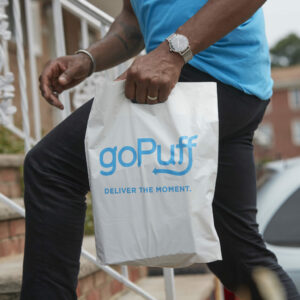From supply chain bottlenecks and labor shortages to increased costs for raw materials, there are price hikes at nearly every step of the food supply chain. On top of that, inflation has caused the price of all consumer goods to increase, from food to gasoline to clothing. This environment has the potential to accelerate competition in the food delivery market as companies try and position themselves as fast and affordable during these challenging financial times.
With the U.S. food delivery market predicted to grow to $43 billion by 2025, the battle for market share is already fierce. The key leaders in the meal delivery space are DoorDash (58 percent), Instacart (8 percent), Uber Eats (8 percent), and Grubhub (2 percent). They’re also joined by a growing number of convenience stores and grocers. And then there are the disruptors, companies hoping to take a slice of the pie by offering something else—ultrafast delivery speeds.
Consumer expectations shifted drastically during the pandemic. Instead of going to restaurants or shopping in grocery stores, consumers turned to online delivery services to bring food and groceries to their homes faster than ever before. Even as restrictions and lockdowns eased, consumers were still willing to pay for the convenience of having whatever they needed delivered on-demand.
Pandemic or no pandemic convenience has always been key, but consumers have completely redefined what convenience means. They now want their items delivered faster—in 15 minutes or less. Ultrafast delivery is a hard enough promise to keep. Given our inflationary times, the real challenge will be delivering at a price point that satisfies consumers. Several companies like Gopuff are taking on this challenge.
Since Gopuff relies on a network of local warehouses to fulfill deliveries, its orders can be completed in as little as 10 minutes. Gopuff isn’t alone in the instant delivery market, but it is way ahead of its competitors, holding 70-75 percent of the first-party U.S. convenience market. The Philadelphia-born company saw sales jump 53 percent in 2021 after a 173 percent surge in 2020, according to a Yipit report. Other established companies like GrubHub and DoorDash are now starting to get into the instant delivery market, but Gopuff has a head start.
It’s been suggested that companies promising ultrafast delivery are biting off more than they can chew in a competitive industry with tight profit margins. Skepticism aside, it stands to reason that there is money to be made. The quick commerce industry was valued at about $25 billion in 2021 and is forecast to expand to $72 billion by 2025. Since 2020, investors have pumped more than $14 billion into the industry.
Gopuffs’ business model stands out in the delivery space. Others rely heavily on third-party vendors to fulfill orders, which can be unreliable and take a large bite out of profits. Gopuff, on the other hand, has built a vertically integrated network of almost 600 micro-fulfillment centers (up from 380 in 2020) it uses to fulfill orders. Those centers store packaged food and household items that customers order on the Gopuff app. Some locations also have “Gopuff Kitchens” that offer prepared meals like pizza or milkshakes.
Those micro-fulfillment centers centralize demand to a single location, enabling Gopuff to leverage industry-leading routing and batching software, provide exceptional customer experience, and allow Gopuff’s delivery partners to return to the same, familiar, location. By owning the inventory and managing the entire experience, Gopuff can take orders 24/7 without having to rely on the same surge prices we see with other delivery services.
The current economic climate will put the delivery market overall under incredible pressure. With prices for food, household items, and gas as high as they are, companies will inevitably have to pass on some of those increased costs to consumers. If they seek the route of increasing prices and delivery surcharges, consumers are likely to turn to other cheaper competitors.
That is where Gopuff has a competitive advantage. Gopuff will be able to keep delivery costs relatively low since its micro-fulfillment centers operate within the neighborhoods of the customers they deliver to. Customers won’t be surprised by added charges on their bills since their delivery rates are fixed.
The company is also developing private-label goods, a cost-effective alternative to buying from third-party sellers that stands to benefit its customers, too. These clear, calculated business moves give Gopuff a real shot at winning the race in the ultrafast delivery space even amid our current economic climate.

